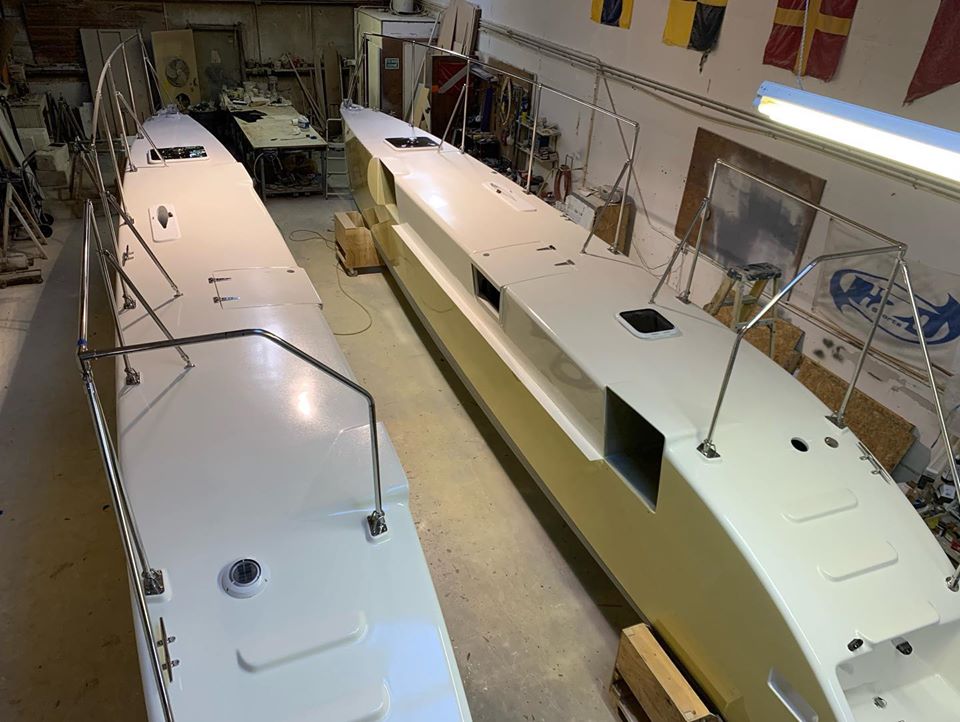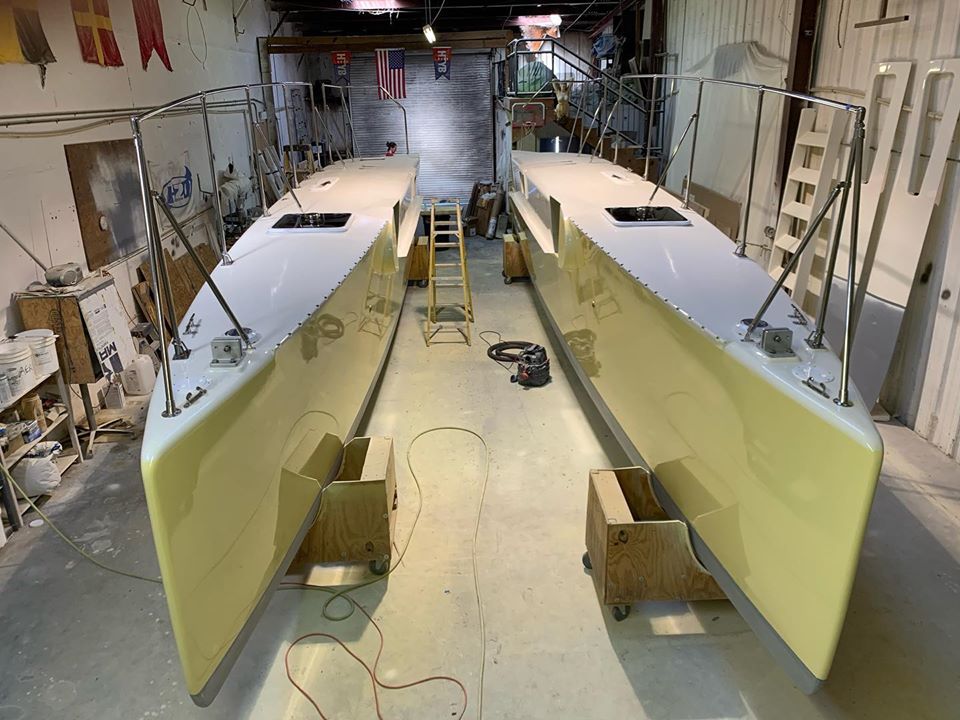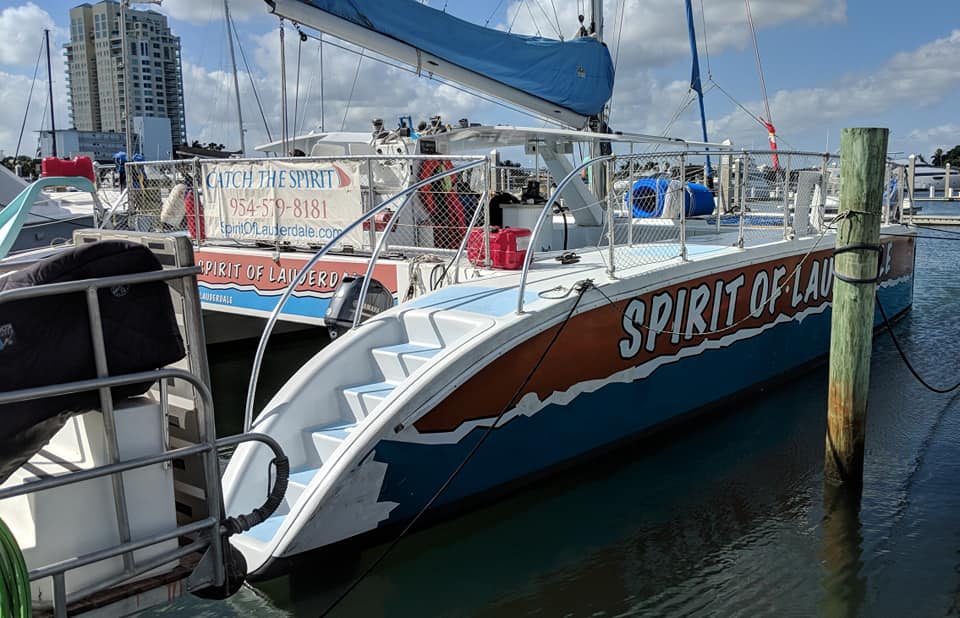Pat’s 36′ KHSD daycharter catamaran is almost there. Beautiful workmanship.


Pat’s 36′ KHSD daycharter catamaran is almost there. Beautiful workmanship.


I found a picture of the new Lake Chelan ferry taken during sea trials.
It was loaded down with about 8000 lbs. of sandbags, which was to simulate 32 passengers and a ton of cargo. It did the required 20 knots, but I thought it should have been able to do better. It still could.
The pair of 200 hp. outboards were still new and weren’t pushed exceed 4000 rpm. The props had not been experimented with.
There was substantial water sloshing around in the bilges. The roll and tip bottom paint application was never tipped. The surface was like sandpaper. The owner can wet-sand the hulls. And finally, there were a few divots below the waterline that could be filled next haul-out.
#lakechelan
#multihulldesigns
#catamaran
#catamaranferry
I got to visit my 49′ daycharter cat in Fort Lauderdale . Always one of my favorites. Met captain Jason.
Built mid 90’s by legendary builder, Andre Cocquyt as a composites class project. Students included IBEX presenter, Belle, Blanding.
Still looks good and can be built remotely from assembly.
https://tropicalsailing.com/sailing-charters-fort-lauderdale-spirit-of-lauderdale/?fbclid=IwAR0jIXoj9Se7ALWvKKRZiAFjUndv53sScGF3A0DNgdf_2uRsG6LcjMKntN8

A screen grab of an upgrade to the 36′ daycharter cat. Foam/glass with flat bagging table used for most of it. Full standing headroom in hulls, and a bit more elbow room. But still a skinny, easily driven waterplane.
24 passenger typically, though JS got 49 pax on his.

For a few decades now I have considered rapid composite hull building construction to be the holy grail of boatbuilding. I published and presented a technical paper on this topic at the 1992 Marine Applications of Composites conference. I built the hulls for my Formula 40 trimaran using the same techniques. A few other catamarans have been built using these techniques. I never have had time to properly write this up as a manual.
I’m still not sure that there is any need for rapid construction any more. I just saw a picture of a race starting line with a row of $3 million to $5 million cats racing. Maybe I really miscalculated the business. Oh well, too late now.
The only other multi designer that I know of working the problem is Kelsall with his flat bagging table KSS process. I see an armload of problems with it. Besides, with that process, one still has to torture the laminate into shape, cut darts into it, then add the 0 degree laminate over the darts, still. And fair it.
What if you could instead build a rapid female mold, and bag the exact and final hull in it in one step? Here we go.
Back in the late 80s when I build my trimaran, a couple of the steps were very successful, and two of them, exhausting. Those two I have improved on.
Those are; I coated the inside of the hull with epoxy. Then sanded it smooth. Way too much work. I now recommend using 545 or some other epoxy primer paint instead. The second was that I coved the hull “gutter” with bog, and then sanded it smooth. Even as a 30 something then, it was insanely hard.to do. Now I prefer to fit a piece of cardboard sonotube first. Then once it is fit properly, bog under it. It creates a rebate on the part that extra protective biaxial roving can be added to.
The first step is to create two cylinder molded reflected hull panels. These can be done with non waterproof glue to save cost. This mold will never go to windward. The insides of the panels are best filled and sanded smooth at the scarphs while the panel is flat like a table.
The two panels are wired together just like the usual CM hull, and a deck flange is added.
The difference between this and the usual CM is that the bulkheads are added to the outside of the hull instead of the inside. Once the final hull shape is achieved.
Red is the flange, purple, the bulkheads, and green the cardboard sono gutter.
One of my customers and friend was in the Keys and got this picture. He wondered if it was a KHSD design. I thought so but wasn’t sure. Pat cleared it all up. Yes, it was the late Chris Schofield’s daycharter cat. It was actually the bridge design between the original Kamanu 36 and the present BIB charter boat in a box 36 design. Probably built in ’90, by Olympic Boat.
I got that great opportunity to see my Alii Nui side by side with a Constant Camber 65 last week. It was great to see the differences. Again, both were built by the same yard. Alii Nui is foam/glass and the CC 65 is constant camber. Except for butting all the plywood sheets instead of scarphs, and bagging the ply to a true mold, instead of itself, this boat’s hulls were built exactly like the CM system that I have been using for 30 years and that CC has been criticizing for almost as long. Cool. Oriented ply sheets. Stringers instead of mass. Thinner hull skin. Cool.
Alii Nui is 36′ wide. I cannot find the CC 65 data online, but I’m guessing it is 30′ or even 32′ wide. That makes a smaller playpen. First the Alii Nui. Both from the same distance on the dock.
The MV Bluebird is undergoing seat trials on Lake Victoria now. It is built from developed plywood/epoxy, with lots of core on flat surfaces. The whole thing went over in several containers after it was built near Seattle. I will be offering an option that is not quite as wide and a little lighter also.
https://www.facebook.com/EWFerries# I see this link only works in Face now. If it gets onto Youtube, I will grab it.
Is it possible that Kamanu is 30 now? I did the working drawings in ’84 I remember. Am pretty sure it was launched by Schooner Creek Boatworks in ’85. http://kamanu.com
Cylinder molded developed plywood/epoxy. My first USCG certified passenger cat. Am sure Derek will froth if he hears about a 30 year old CM cat still going out every day.